What is an Arcade?
An arcade is a succession of arches, supported by columns or piers.
Description
An arcade is a structural design element that consists of a series of arches supported by columns or piers, often lining a walkway or open space. This architectural feature is not only functional, providing covered pathways and structural support, but also aesthetically pleasing, adding rhythm and visual interest to spaces both exterior and interior. In interior design, arcades can create a dramatic effect, segmenting large spaces, framing views, and providing a sense of grandeur or historical context. They can be found in a variety of design styles, from classic Roman and Gothic architecture to more contemporary applications that play with materials, proportions, and forms. Depending on the context, an arcade can add architectural character to commercial spaces, public buildings, and residential architecture, making it a versatile and impactful design element.
Usage
Arcades are commonly found in traditional and historical buildings, such as churches, government buildings, and universities, where they serve both decorative and functional roles. In modern architecture, arcades are often used in commercial complexes, shopping centers, and residential developments to provide covered walkways and aesthetically pleasing architectural details. Interior arcades might be used in large hallways, public lobbies, or as a distinctive architectural feature in grand living spaces.
FAQs
-
Can arcades be used in contemporary interior design?
Yes, arcades can be used in contemporary interior design. Modern interpretations of arcades often experiment with materials, such as steel and glass, and can be adapted to various aesthetic and functional purposes, creating a blend of traditional and contemporary design elements.
-
Are arcades only used in large public buildings?
No, while arcades are commonly associated with large public buildings, they can also be incorporated into residential architecture and smaller spaces. Interior arcades can add depth, character, and visual interest to living rooms, hallways, and even outdoor living areas.
-
What materials are commonly used for arcades?
Historically, arcades have been constructed from stone, brick, or concrete. However, modern arcades might also incorporate metals like steel, and even glass, allowing for a wide range of aesthetic and functional applications.
Practical Application
When incorporating an arcade into your design, consider the scale and style of your space to ensure that the feature complements rather than overwhelms. Utilize materials and proportions that align with the overall design theme, and think creatively about how this architectural element can enhance the function and appearance of the space. For example, a glass and steel arcade could add a modern twist to a traditional design, bridging the past and present.
-
Architectural Elements199 articles
-
Design Styles478 articles
-
Materials & Textiles360 articles
-
Construction & Building86 articles
-
Historical Periods & Movements150 articles
-
MullionA vertical bar between the panes of glass in a window.
-
GuillocheGuilloche is a decorative technique involving intricate, interlacing patterns.
-
MoiréMoiré is a unique visual phenomenon produced by the superimposition of two or more sets of fine patterns or grids.
-
Hardwood FramesHardwood frames refer to the structural frames of furniture made from hardwood.
-
CinquefoilCinquefoil is an architectural motif used primarily in Gothic architecture.
